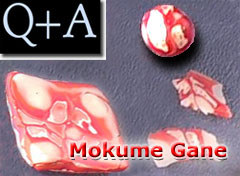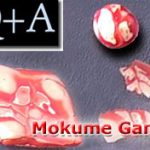
Polymer Clay Projects – Large Beads From Mokume Gane Covered Wood
How to make big beads for jewelry making projects without using up too much of your precious Fimo or Premo Sculpey Clay:
More...
Q: “My question is this: Can I attach mogame slices to wood? I tried to and it wouldn’t stick. Can you use some kind of adhesive? I’m trying to save my clay by using wood balls as the inside.” ~Mary Ellen Soffee
A: The nice thing about Mokume Gane is that you can use thin slices of this beautifully patterned clay to cover a multitude of things. So your idea of saving clay by using the slices to cover wooden balls instead of clay ones, is good.
However, there are some problems to be aware of when covering wood with polymer clay. Sometimes there is a finish or a residue on the wood that the clay won’t stick to. Plus, there is the issue of the wood being porous.
Porous materials can absorb moisture from cool damp air, and then expel it again when the dryness returns. This causes expansion and contraction. In other words, a wooden ball can actually change size according to the fluctuating temperatures and moisture levels of the air surrounding it.
This creates problems when you try to layer something rigid and non-porous, like baked polymer clay, over top of something porous like wood. The hardened clay will only stretch so far before it cracks or breaks.
There are ways to seal the wood so that it does not absorb moisture and will accept the polymer clay. I published some tips about doing this in an article about covering wooden door pulls with Fimo clay. Here’s the link: Polymer Clay Bathroom Knobs
Another “dummy bead” solution to conserve on the amount of clay required to make your over-sized beads, is to use something that’s non-porous and that’s also readily available… like tin foil! More about this idea here: Making Large Polymer Clay Beads
Thanks, Mary, for sending in your polymer clay project question about making large Mokume Gane beads. It is always nice to have lots of creative options for working with polymer clay. If you have further questions about this topic, please use the comments section below. To send me questions about new topics, use the contact Cindy Link at the top of this page.
Sponsored Ads & Special Promotions


Want to chat about today’s post? That’s what the comment section below is for. Scroll Down… We’d love to hear from you!
Or... if you would like to request a topic for a future post, here is the link to do that… PcT Suggestion Box

My problem is, I bought a resin at the craft store. This resin I use it over wood. I try to use it over polymer clay and it stayed sticky. Must I use an special resin?
@Rosita Cortés: What brand did you use Rosita? Are you covering clay that is baked or unbaked? I usually use a UV Resin but most resins should work, if your piece is clean and baked properly.
@Cindy Lietz from UV Epoxy Resin on Polymer Clay:
Cindy;
The clay was baked and clean. I will try with the epoxy resin. But I must wait
until I go to US in June. Here in Chile they don’t sell it. After that I will tell you how it did worked.
Thank you. You always help me. I’m so happy to follow with your classes.
Rosita Cortés
I just wanted to add this here from Mary Ellen Sofee, the reader who asked the original question for this Q+A article. She provided some information from the Carol Duvall Show about using all purpose glue to cover wood before covering with polymer clay. To read her full comment, simply click on the the “Skinner Blend” link right beside my name above. It will take you directly to where Mary Ellen had posted the details.
Thank you for the excellent tip Wendy!
Cindy Lietz’s last blog post..Blue Iris Color of the Year – Perfect for Making Polymer Clay Beads
@Cindy Lietz from Bead Making Basics:
I can’t find the answer to this question in the search box. I bought a bunch of elements beads on clearance. Some of them look cheap, but have a nice shape. I don’t know if they are made from resin or plastic. Can these beads be used as a base and covered with clay and baked?
@Lisa Potter: Sorry Lisa, Doug just pointed out that I missed this question from you. Yes you can cover any type of bead you wish with polymer clay, as long as it is heat safe. Pretest your ‘cheap’ core bead before covering in clay in the oven at 275F for at least 15 min, to see whether it will melt or not. If it doesn’t melt, try covering it in clay and then bake it, to see how that goes.
Some beads may have strange finishes or get super hot on the inside, so I would still consider it a test bead until you tried both tests first. In other words, don’t make up a bunch of wonderfully detailed covered beads until you know the beads going to work.
If you do experiment, take some pictures and let us know how it goes. Everyone here loves a little Mad Scientist Testing, so do share… even if it goes horribly wrong! :-)
You can also pop the wood in the oven to dry it out before you seal it , just to be sure it won’t expand due to moisture. Set the oven temp @ 250 degrees and bake for 30 minutes, or less depending on the size of the wood object to be covered.